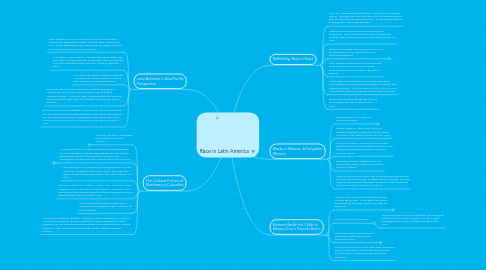Race in Latin America
作者:Dee Villa


1. Latin America in Asia-Pacific Perspective
1.1. There has been a long and continuous historical connection between this large region Iberian, and later Latin, America and Asia. Asians established small communities in Mexico already at the beginning of the seventeenth century.
1.2. Asian labor in Latin America. Chinese labor was initially most prominent in these population movements, staring around the turn of the twentieth century and later joined by Japanese labor.
1.3. Peru and Cuba, both actively promoted the importation of Chinese coolies or contact laborers to work on sugar plantations.
1.4. The British were the first to experiment with the exporting of Chinese, then East Indian, laborers under contract to their overseas colonies. As early as 1806, a precisely the time when the British ended the slave trade, two hundred Chinese were sent to Trinidad.
1.5. By the second and third decades of this century, Peru and Brazil were the foremost recipients of Japanese labor in the Western hemisphere. By 1940, there were 234,574 immigrants of Japanese origin in Latin America, nearly 48 percent of all Japanese living abroad outside of Asia.
2. The Cultural Politics of Blackness in Colombia
2.1. Colombia has one of the largest black populations in Latin America.
2.1.1. Project specifications
2.1.2. End User requirements
2.1.3. Action points sign-off
2.2. A number of small and often transient movements appeared during the seventies, but two organizations still exist and are quite representative of the scene: the Center for the Investigation and Development of Black culture, and Cimarron .
2.2.1. Define actions as necessary
2.3. The ideology of cimarronismo by the organization Cimarron. Cimarron in Spanish literally means "feral" and is typically applied to something domesticated, like cattle, that has "run wild."
2.4. The new Constitution, ratified on July 5, 1991, contained clauses recognizing the "multiethnic and pluricultural" character of the nation, which theoretically helped the cause of people seeking to push blackness into the political arena.
2.5. This official representation of blackness in Colombia has emerged through a complex set of relationships.
2.6. Blacks are no longer as "invisible" as they once were (Friedemann 1984); the "smooth maintenance" of racial inequality has been disrupted; and while blackness has not entered mainstream politics in the same way as in Jamaica, Guyana, or Haiti, it has entered the political arena, albeit in marginal position.
3. Rethinking Race in Brazil
3.1. May 13th 1988 Brazil celebrated their 100th year of abolishing slavery. Although slaver was abolished the Afro-Brazilian group feels as if the abolition never happened. They protested against it, saying that it was a fake abolition.
3.2. UNESCO sponsored research constituting racial revisionism. Racial revisionism was full of insights into Brazilian race but had its limitations like reducing race into class.
3.3. Florestan Fernandes work was great because of the recognition of the centrality of race in Brazil's development.
3.3.1. Included
3.3.2. Included
3.3.3. Excluded
3.4. Many people analyzed race and class in Brazil and exposed that racial democracy was nonexistent in Brazil, but failed to provide a solution.
3.5. As the abertura advanced and democratic opposition consolidated and expanded, blacks began to mobilize and organize as blacks, With the creation of the MNU in 1978 a national black political movement was brought into being.
3.6. Blacks have created other groups in which they organize like CEAP, CERNE, and IPDH
4. Blacks in Mexico: A Forgotten Minority
4.1. Black Mexicans, Afro Mexicans, Mexicanos Negros
4.1.1. Materials
4.1.2. Personel
4.1.3. Services
4.1.4. Duration
4.2. Gaspar Yanga an African slave that led a Rebellion against the Spanish colonial masters in Mexico in the pueblo named after him Yanga.
4.3. The Black Mexicans are heavily discriminated against and don't have a cultural identity because they are not recognized by their country as a separate culture.
4.4. The Black Mexicans neighborhood lack resources for better living and schools for children to attend.
4.5. They don't know much about their ancestors past because their history is not really thought or talked about in any way. The only thing they know is that their Black ancestors arrived chained on boat that docked in the port of Veracruz.
5. Koreans Battle the Odds in Mexico Citiy's Poorest Barrio
5.1. Tepito is one of Mexico's oldest barrios where Koreans set up shop. In this Barrio the people were reluctant to accept anyone new after the Spaniards.
5.1.1. Dependencies
5.1.2. Milestones
5.2. "The invasion of the Koreans"
5.2.1. They speak pigeon Spanish and hard to get along with stated one of the locals of Tepito. He also thought that they were the cause of drugs coming to their town.
5.3. There were about 1,000 Koreans in Mexico as a whole due to strict immigration rules.
5.3.1. KPI's
